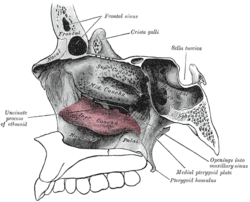Inferior nasal concha facts for kids
| Bone: Inferior nasal concha | ||
|---|---|---|
| Medial wall of left orbit. (Inferior nasal concha visible in center in yellow.) | ||
| Figure 1: Lateral wall of right nasal cavity showing inferior concha in situ. (pink) | ||
| Latin | Concha nasi inferior, concha nasalis inferior |
|
| Articulations | Ethmoid, maxilla, lacrimal and palatine bone | |
The inferior nasal concha (say: KONG-kuh) is a special bone inside your nose. It's also called the inferior turbinate bone. You have two of them, one on each side of your nose. These bones are part of your face bones.
This bone is thin and curved, like a scroll. It sits along the side wall of your nasal cavity, which is the space inside your nose. When you breathe, air goes past these bones. They help warm, moisten, and clean the air before it reaches your lungs.
There are other similar bones higher up in your nose, called the middle and superior nasal conchae. But those come from a different skull bone called the ethmoid bone, which is part of your braincase.
Contents
What the Inferior Nasal Concha Looks Like
This bone has two main sides, two edges, and two ends.
The Surfaces
- The medial surface is the side facing the middle of your nose. It's a bit rounded and has small holes and grooves. These grooves are for tiny blood vessels.
- The lateral surface is the side facing the outer wall of your nose. It's curved inward, forming part of a space called the inferior meatus.
The Borders
The upper border is thin and uneven. It connects to several other bones in your nose. This upper edge has different parts:
- The front part connects to your maxilla (upper jaw bone).
- The back part connects to your palatine bone (a bone in the roof of your mouth).
- The middle part has three small bumps or "processes." These processes can look different in different people.
- One process, called the lacrimal process, is small and pointy. It helps form a small canal for your nasolacrimal duct, which carries tears from your eye to your nose.
- Another process, the ethmoidal process, is a thin plate that connects to the ethmoid bone.
- A third process, the maxillary process, curves downward. It connects to your maxilla and helps form part of the wall of your maxillary sinus (a hollow space in your cheekbone).
The inferior border is the bottom edge of the bone. It's free, meaning it doesn't connect to other bones. This edge is thicker and has a spongy texture, especially in the middle.
The Ends
Both ends of the inferior nasal concha are somewhat pointed. The back end is usually more tapered than the front.
How it Develops
The inferior nasal concha starts to form when a baby is about five months old inside the mother. It develops from a single center of bone growth in the side wall of the nose's cartilage.
Images for kids
See also
 In Spanish: Cornete nasal inferior para niños
In Spanish: Cornete nasal inferior para niños
- Empty nose syndrome
- Nasal concha






